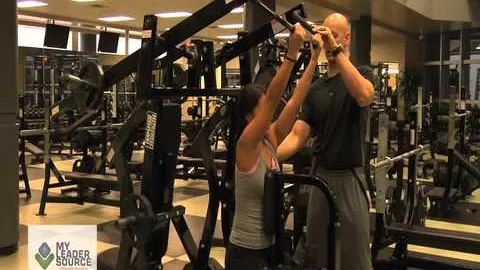
Are you looking for an effective upper body exercise to incorporate into your workout routine? Look no further than the isolateral pull down exercise. This compound movement targets multiple muscles in your upper body, helping you develop a well-rounded physique. In this comprehensive guide, we will delve into the specifics of this exercise, its benefits, proper form, variations, and tips to maximize your results.
The isolateral pull down exercise primarily targets the latissimus dorsi muscles, commonly known as the lats or the "wings." Additionally, it engages other muscles including the rhomboids, lower trapezius, biceps, and forearms. This exercise is performed using a cable machine or a lat pull down machine, making it accessible for anyone with access to a gym.
The isolateral pull down exercise is an effective way to increase upper body strength. By targeting the latissimus dorsi muscles, you'll be able to improve your pulling strength, which translates to various daily activities, sports, and other exercises.
If your goal is to build a well-rounded upper body, the isolateral pull down exercise should be a staple in your routine. It targets multiple muscle groups simultaneously, allowing for efficient muscle development. With consistency and progressive overload, this exercise can help you achieve a broader back, defined shoulders, and improved posture.
In today's world, many individuals spend a significant amount of time hunched over desks or electronic devices, leading to poor posture. The isolateral pull down exercise can help counteract this by strengthening the muscles responsible for proper posture, namely the muscles in your upper back and shoulders. By incorporating this exercise into your routine, you may experience enhanced postural alignment and reduced risk of developing posture-related issues.
One of the beauties of the isolateral pull down exercise is its versatility. It can be performed using different grip variations, such as wide grip, close grip, underhand grip, or using various attachments. This variability allows you to target different muscles within your back and arms, providing a well-rounded upper body workout.
To perform the isolateral pull down exercise correctly and efficiently, follow these steps:
It is crucial to maintain proper form throughout the exercise. Avoid swinging your body or using momentum to lift the weight. Instead, focus on engaging your back muscles and controlling the movement to ensure maximum effectiveness and prevent injury.
While the standard isolateral pull down exercise is highly effective, incorporating variations and alternatives can add variety to your routine and target specific muscles differently. Some popular variations and alternatives to consider include:
By using a close grip on the cable bar, you shift the emphasis from the lats to the middle back muscles, such as the rhomboids and lower trapezius. This variation can help develop greater thickness and detail in your back.
The wide grip pull down focuses more on the outer lats, helping you achieve a broader back. By using a wider grip, you engage the muscles differently, providing a new stimulus to support overall back development.
The underhand grip pull down, also known as the reverse grip pull down, primarily targets the biceps and forearms while also engaging the lats. This variation is ideal for those looking to specifically target the biceps or add variety to their routine.
If you don't have access to a lat pull down machine, there are alternatives you can try to target similar muscles. These include bent-over rows, dumbbell rows, or assisted pull-ups using resistance bands. These exercises provide a similar stimulus to the isolateral pull down exercise and can be equally effective in developing upper body strength.
To make the most of your isolateral pull down exercise, consider the following tips:
In conclusion, the isolateral pull down exercise is an excellent choice for targeting multiple muscles in your upper body. By incorporating variations and maintaining proper form, you can achieve increased strength, muscle development, and improved posture. Remember to consult with a fitness professional, if needed, to ensure proper execution and alignment with your specific goals. Get ready to elevate your upper body training and reap the benefits of this effective exercise!
If you're looking for a gym, fitness club or yoga studio, you've come to the right place.
You can find information about gyms in your area. Browse catalog of gyms and find gyms with classes which are you looking for.
On gym page you can find simple information like address, phone or website. You can find list of available classes. You can check availability of personal training or small group classes. On place page you can also see information about open hours.
You can find gyms near you with amenities, courts, studios and equipments.
Use our map to find gym at your city or district.
In Gym Navigator you can find list of exercises with movies for many body parts.
You can browse exercises catalog and find exercises the best of you.
You can also find exercises grouped into workout plans, which you can use to improve you body. Each routine show you exercises one by one and give you possibility to count you progress and count down rest time.